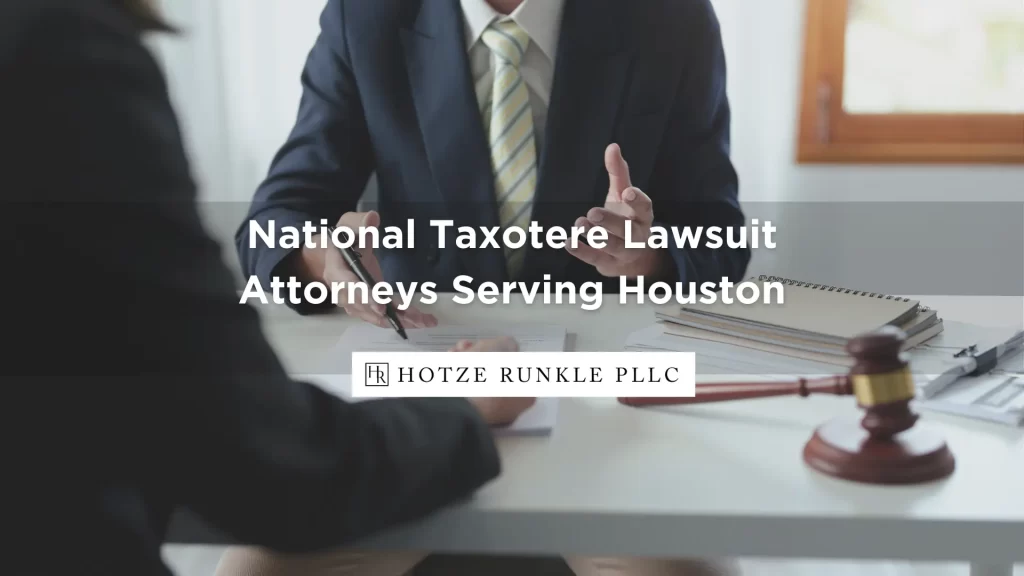
When you have canalicular stenosis, a serious ocular condition, you may experience blurred vision, sensitivity to light, swollen eyelids, headaches, and, most notably, excessively teary, watery eyes. The condition can make it hard to read, drive, watch television, or even attend social events.
If you have developed canalicular stenosis as a result of taking the chemotherapy drug Taxotere, you may be entitled to compensation.
Canalicular stenosis is a serious side effect of the chemotherapy drug Taxotere. If you develop any symptoms related to canalicular stenosis during or following your Taxotere treatment, it’s important to let your oncologist know immediately. Canalicular stenosis is irreversible and prompt treatment can prevent the condition from worsening.
Hotze Runkle PLLC understands how frustrating it is to be grappling with an eye condition that never should have developed in the first place. Canalicular stenosis is preventable when early symptoms are treated and monitored closely by an ophthalmologist. Unfortunately, many patients and doctors didn’t know about the link between Taxotere and canalicular stenosis.
People around the country have filed lawsuits against the manufacturer of Taxotere, Sanofi-Aventis, and many stated that Sanofi-Aventis was negligent in providing a dangerous drug to doctors and patients. The plaintiffs alleged that the pharmaceutical company was aware of the side effects but hid them from the FDA and its consumers. Despite Taxotere’s availability since 1998, Sanofi-Aventis didn’t release any warnings about the drug’s adverse reactions until 2014.
At Hotze Runkle PLLC, we are committed to helping every one of our clients receive the full, fair compensation they deserve. We are highly experienced in these types of cases, and we have the resources to hold Sanofi-Aventis accountable for the pain you’ve suffered.
Take our brief Taxotere Quiz to see if you may be eligible for compensation from Sanofi-Aventis.
Symptoms Experienced from Taxotere Chemo
During their chemo with Taxotere, many cancer patients noticed a strange symptom known as epiphora. Epiphora is the condition of having watery eyes, which may result from problems with the tear duct. When functioning correctly, tears spread across the eye and drain into holes at the corners, funnel through a tube called the canaliculus and into the nasal cavity. Certain medical conditions can cause the tears to build up on the surface of the eye and then roll onto the cheeks.
If epiphora is left untreated, it can develop into canalicular stenosis, which is a more serious ocular condition. The symptoms people experience range from mild to severe and include the following:
- Blurry or cloudy vision
- Eye infections and irritations
- Sensitivity to light
- Excessive tears
- Headaches
- Swollen eyelids
- Dry eyes
- Eye-watering
Many people will brush off their symptoms as insignificant. They chalk it up to their chemo treatment and don’t mention anything to their oncologist. They try to cope as best they can and wait for the symptoms to go away on their own. However, canalicular stenosis can progress and get worse long after Taxotere chemotherapy ends.
Why Does Taxotere Cause Symptoms of Epiphora and Canalicular Stenosis?
Studies found how Taxotere reacts with a person’s tears as they travel through structures within the eye. When a physician administers the drug intravenously, secretions from the drug come in direct contact with tears and other bodily fluids. A reaction causes inflammation in a vital ocular structure called a canaliculus.
The canaliculus is supposed to funnel tears from the tear duct into the nasal cavity. Chronic inflammation caused by Taxotere can lead to an obstruction that prevents the proper drainage of tears. When that happens, the tears build up on the surface of the eye and get released.
If you don’t go to a doctor to treat your chronic inflammation, it could develop into canalicular stenosis, an irreversible medical condition. Canalicular stenosis occurs when chronic inflammation leads to an infection and causes the canaliculus to become blocked. In the early stages, you can manage your symptoms with medical intervention. However, when it progresses, the blockage grows and could cause partial or total closure of the canaliculus.
Watery eyes may seem like a minor issue, but it can negatively impact someone’s life and daily routine. It makes simple tasks, such as driving, extremely difficult. It also affects the emotional and psychological well-being of anyone experiencing those symptoms.
What Are the Options for Treating Canalicular Stenosis?
Unfortunately, canalicular stenosis is a permanent condition. If it hasn’t progressed, an ophthalmologist might be able to monitor your health and manage the eye-watering with the use of eye drops. A topical steroid could also alleviate inflammation and prevent additional obstructions in the canaliculus.
If your canaliculus closes, the only option available to try to manage your symptoms is an invasive and expensive surgery. Dacryocystorhinostomy (DCR) is a procedure that creates a passageway in the ocular cavity for tears to travel to the nasal cavity.
The surgeon either reconstructs adjacent structures in the eye or places a stent to redirect tears away from the damaged canaliculus. The surgery isn’t painful but does come with risks. The side effects you might experience include:
- Uncontrollable hemorrhaging
- Damage to nasal and ocular tissue
- Eye infections
- The body’s rejection of the stent
- Significant scarring
- Stent migration
- Blindness
- Ineffective procedure
If the obstruction of one or both canaliculi is so advanced that DCR isn’t possible, the doctor could perform CDCR. Conjunctivodacryocystorhinostomy is similar to DCR in that the surgeon creates a new tunnel for tears to travel. With no viable eye structures to use for a new passageway, a Jones tube (a tiny glass tube) gets placed where the damaged canaliculus was. CDCR is only available to patients with extreme cases of canalicular stenosis and comes with the same risks as DCR.
Can I Continue Chemo While Treating Canalicular Stenosis Symptoms?
Yes. Once you notice any unusual symptoms, you should notify your oncologist and consult with an ophthalmologist. It’s possible to continue chemotherapy while treating and managing your canalicular stenosis symptoms. In some situations, your doctor could place a temporary stent to keep your tears from running down your face and prevent further obstruction of the canaliculi.
Can I Sue My Doctor for Treating My Cancer with Taxotere?
Most physicians were completely unaware of the dangerous link between Taxotere and canalicular stenosis. It’s unlikely that your oncologist knew of the potential side effects while administering the drug. If you’re considering filing a lawsuit, you should file against the pharmaceutical company Sanofi-Aventis.
Hotze Runkle PLLC might be able to help you with your lawsuit against Sanofi-Aventis for their participation in manufacturing and distributing a defective product. Pharmaceutical companies are supposed to ensure safe manufacturing and honest marketing efforts. Sanofi-Aventis negligently sold a chemo drug they knew was dangerous.
In product liability cases, discovering negligence on the part of a company entitles those affected to pursue legal action. In the state of Texas, the statute of limitations for filing a lawsuit is two years. If you want to recover compensation for your damages, you only have two years from the date your symptoms started to sue Sanofi-Aventis.
What Are Damages?
Damages are the total losses suffered as a result of someone else’s negligence. There are three different categories of damages:
- Economic: Expenses, such as medical bills.
- Non-economic: Intangible losses, such as emotional distress.
- Punitive: Punishes the responsible party and aims to prevent continued acts of negligence.
In a product liability lawsuit, you can claim the damages such as the following:
- Past and future medical costs
- Physical pain and suffering
- Mental anguish
- Disfigurement
- Physical impairment
- Past and future loss of income
- Loss of consortium
- Loss of household services
A jury may determine the financial award you deserve. They will take into account your total bills, as well as the non-economic damages you suffered. Some of the factors they will review include:
- The severity of your symptoms
- Length of time to recover
- Future treatment needed
- Invasiveness of medical procedures
- Time spent away from work
- Effect of the symptoms on your lifestyle
Hire a Houston Taxotere Lawsuit Lawyer
 The experienced lawyers at Hotze Runkle PLLC understand you’re going through physical and emotional trauma. It’s devastating knowing you could have prevented the side effects you’re experiencing if you were aware of the dangers of Taxotere.
The experienced lawyers at Hotze Runkle PLLC understand you’re going through physical and emotional trauma. It’s devastating knowing you could have prevented the side effects you’re experiencing if you were aware of the dangers of Taxotere.
Sanofi failed in its duty to warn you about the harmful reaction between the drug and tears. We’ll help you fight for justice and make sure you receive the monetary award you need to cover your damages.
When you hire us, we’ll take care of every step of your case, so that you can focus on your health and moving forward. You will always be a priority for us. We’ll walk you through the legal process, answer your questions, and keep you updated on the status of your case.
You can schedule a free consultation to meet with one of our dedicated Houston Taxotere lawsuit lawyers. We’re happy to speak with you about your symptoms and review the documentation you can provide. We’ll let you know the legal options available to you and how you should proceed with your case.
If you treated your cancer with Taxotere and developed canalicular stenosis symptoms, take our Case Evaluation Quiz to determine if you qualify for a lawsuit.